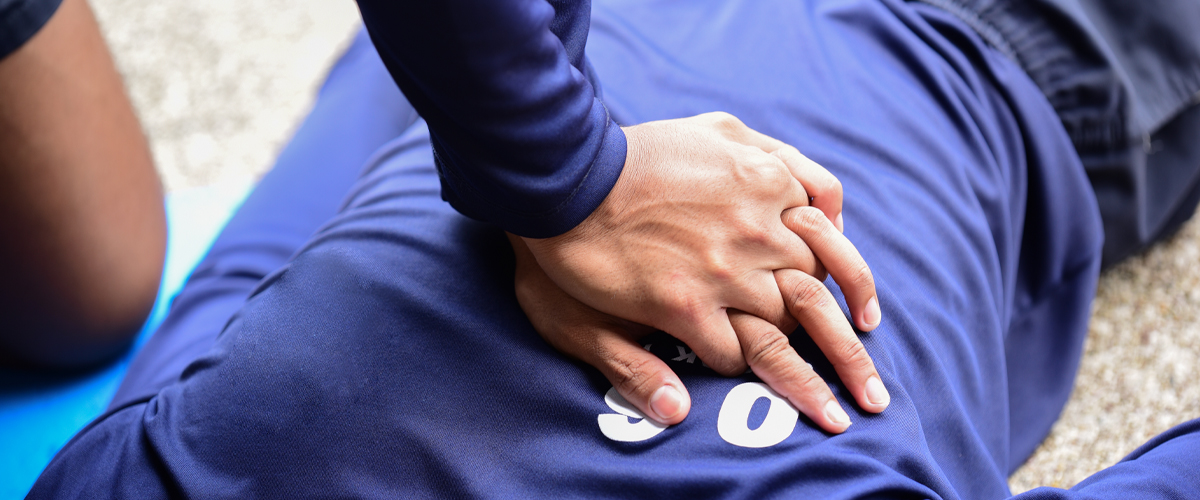What Is Cardiac Arrest? Here’s What to Know
Learn the signs of cardiac arrest, what can cause it, and who is at risk.


Cardiac arrest — when the heart suddenly stops functioning — occurs outside of a hospital in more than 356,000 people each year, according to the American Heart Association.
The life-threatening cardiac event gained wide attention when Buffalo Bills safety Damar Hamlin collapsed on the field during a Monday Night Football game after completing a seemingly routine tackle. The Bills later announced that Hamlin’s heart had stopped and he was resuscitated before taken to the hospital.
“During cardiac arrest, a dangerous heart rhythm prevents the heart from pumping. As a result, the heart can’t pump blood to the brain, lungs, or other organs,” says Dr. Sonia Tolani, a cardiologist specializing in sports cardiology and co-director of the Women’s Heart Center at NewYork-Presbyterian/Columbia University Irving Medical Center. “People can die or have serious, unrecoverable injuries unless blood flow is restored very quickly.”

Dr. Sonia Tolani
Dr. Tolani, who is also an assistant professor at Columbia University Vagelos College of Physicians and Surgeons, spoke to Health Matters about the heart condition, including the difference between a heart attack and cardiac arrest, what leads to cardiac arrest, and what needs to be done when an event occurs.
How is a heart attack different from cardiac arrest?
A heart attack is related to circulation, or blood flow. During a heart attack, a blockage in an artery stops blood flow to the heart. Part of the heart muscle tissue begins to die as a result of blood supply loss.
In a cardiac arrest, the heart’s electrical system malfunctions, leading to arrhythmias, or irregular heart rhythms. Due to this malfunction, the heart can suddenly stop beating.
Heart attacks don’t always result in a cardiac arrest, but when cardiac arrest occurs, a heart attack can be a common cause. When there’s a blockage of the artery and the muscle isn’t getting enough blood flow, a dangerous arrhythmia could start.
What else can cause cardiac arrest?
Many other factors can lead to cardiac arrest. Major causes can include:
- Genetic abnormalities that can result in abnormal heart muscle.
- Underlying heart damage that can be a result of a heart attack or other cardiac events.
- Electrical abnormalities, in which a person’s heart is predisposed to heart rhythm issues.
In young patients, particularly athletes, other rare causes may be considered, including abnormalities in the coronary arteries that someone is born with, inflammation of the heart from a viral infection, or commotio cordis — blunt force trauma to the chest. Up to a third of cardiac arrest in athletes may be unexplained.
How common is commotio cordis and what do we know about it?
This is a rare occurrence in which there’s a blow to an exact part of the chest at an exact moment of the heart cycle. The most textbook example of this event is in little league when a kid gets hit in the chest by a fastball. And that impact to the heart, if it happens at the wrong timing between heartbeats, triggers a fatal arrhythmia.
Cardiac arrest in young athletes is typically very different from what’s going to be seen in the general population. In the general population, most cardiac arrests are going to happen in older people, and overwhelmingly the number one cause for cardiac arrest would be a heart attack.
What are risk factors of cardiac arrest and can it be prevented?
Sudden cardiac arrest can happen to people who didn’t realize they had heart disease. But often, they may have had some sort of warning sign, like chest pain or shortness of breath, that they misunderstood or ignored.
People who have underlying heart conditions, heart failure, or genetic cardiomyopathies are at risk.
According to studies, sudden cardiac arrest is more common in men than women.
Good preventative cardiac care and a healthy lifestyle can help lower your risk. Regular doctor visits and treatment for conditions such as high blood pressure, high cholesterol, and diabetes can make a difference.
How is cardiac arrest treated?
The fastest thing to do is CPR, specifically Hands Only CPR, where you manually help circulate the blood for the heart at 100 compressions per minute.
Family, friends, or bystanders can make an immediate difference to help a person who is experiencing cardiac arrest outside of a hospital. If performed in the first few minutes, CPR can double or triple a person’s chance of survival.
Immediately following CPR, an automated external defibrillator (AED) is very important to shock the heart into a regular heart rhythm.
The big issue is time: You want to start restoring the blood flow as quickly as possible. The longer you go without it, the increased risk of irreparable damage.
Additional Resources
Watch how to do Hands Only CPR
Get more information about cardiac arrest
Learn about our comprehensive cardiovascular services

